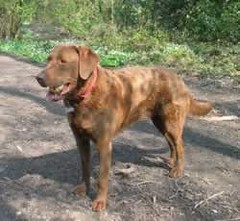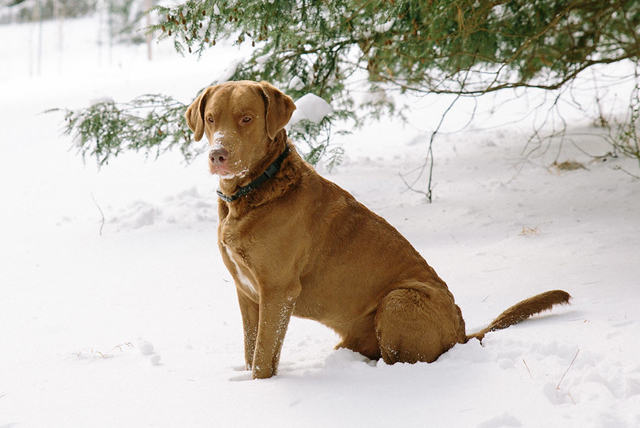Chesapeake Bay Retriever
No products found which match your selection.
Shelter Dog Meal Donation Count:
No products found which match your selection.
The Chesapeake Bay Retriever is a robust, intelligent breed ideal for active families or individuals who enjoy outdoor activities. Their loyalty and protective nature make them excellent companions, while their energy and intelligence call for engaging training and exercise routines. Despite their independent streak, with the right training and socialization, they can be a well-behaved member of the family. Their unique coat and love for water also make them standout pets for those living near water bodies or who enjoy water sports.
The Chesapeake Bay Retriever, affectionately known as the “Chessie,” is renowned for its strength, endurance, and proficiency in water. Initially bred for hunting waterfowl in the rough and icy waters of Chesapeake Bay, they are strong swimmers with an extraordinary ability to retrieve.

The breed originated in the United States in the 19th century. The foundation stock was said to be two Newfoundland puppies rescued from a shipwreck in Maryland and then bred with local retrievers.




Prone to hip dysplasia, progressive retinal atrophy, and other genetic conditions. Regular health screenings and veterinary check-ups are recommended.
Requires moderate grooming. Regular brushing to maintain coat health and occasional baths. The coat should not be over-bathed to preserve its natural oils.
High exercise needs; requires regular, vigorous activity. Enjoys swimming, retrieving games, and outdoor activities.
Intelligent but can be independent and willful. Requires consistent, positive training methods. Early socialization and obedience training are crucial.
A balanced diet is suitable for their size and high energy level. Monitor food intake to prevent obesity, especially in less active dogs.
Caring for a Chesapeake Bay Retriever requires a commitment to exercise, training, and grooming needs. They are best suited for active families who can provide them with ample physical activity and engagement. With proper care, including regular veterinary visits and a suitable diet, Chessies make loyal and loving companions.
Chesapeake Bay Retrievers are generally robust and healthy, but like all breeds, they have predispositions to specific health issues. Awareness of these conditions and appropriate preventive measures can help maintain their health.
Understanding these common health issues and adhering to the recommended testing and preventive care guidelines can help ensure a healthy, happy life for a Chesapeake Bay Retriever. Collaboration with your veterinarian is key to tailoring a healthcare plan to your dog's needs.
The iHeartDogs Free Rx Discount Card Program is a pet prescription discount card that can help you save money on your furry friend’s medications. The card is free to sign up for, and you can use it at participating pharmacies nationwide. To use the free program, simply show the card to your pharmacist when you pick up your pet’s prescription. The pharmacist will then scan the card, and you will receive a discount on the price of the medication.LEARN MORE
Caring for a Chesapeake Bay Retriever involves various expenses that can vary depending on your location, the dog’s age, your health, and your personal choices regarding care. Here’s a breakdown of typical expenses:
Total Estimated Annual Cost:
$2900 - $7300
It's important to note that these figures are estimates and can vary. Also, the first year of owning a dog can be more expensive due to one-time costs like spaying/neutering, initial vaccinations, and training. Regular budgeting for your dog's needs and an emergency fund for unforeseen costs are essential for responsible pet ownership.